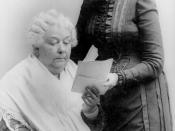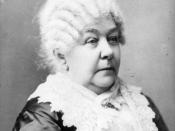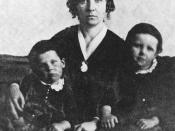Not ago, in the nineteenth century, the words that our forefathers wrote in the Declaration of Independence, "that all men were created equal," held little value. Human equality was far from a reality. Therefore, if you were not born of white male decent, than that phrase did not apply to you. During this period many great leaders and reformers emerged, fighting both for the rights of African Americans and for the rights of women. One of these great leaders was Elizabeth Cady Stanton. Stanton dedicated her entire life to the women's movement; despite the opposition, she received, from both her family and friends. In the course of this paper, I will be taking a critical look at three of Stanton's most acclaimed speeches "Declaration of Sentiments", "Solitude of Self", and " Home Life", and develop a claim that the rhetoric in these speeches was an effective tool in advancing the movement as a whole.
Elizabeth Cady Stanton was born November 12, 1815, in Johnstown, New York. She was born unto a conservative, Presbyterian family of considerable social standing. Her father, Judge Daniel Cady, was considered both a wealthy landowner and a prominent citizen with great political status (Banner 3). Stanton was one of seven children, six of which were girls, to be born to Daniel and Margaret. Growing up in the period that she did, Elizabeth was very fortunate to receive the outstanding education that she did since it was not as important to educate daughters, as it was sons. She overcame that boundary when she began attending Johnstown Academy. She was the only girl in most of her classes, which was unheard of in those days. Even when females did attend schools, they were learning about "womanly" things, like how to run a household, not advanced math and science...



Very Good
It has references, which is more than you can say about most of the essays on this site.
0 out of 0 people found this comment useful.